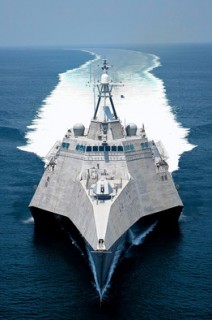
By NATHAN HODGE
WASHINGTON—This summer, the Navy expects to choose between two competing designs for the Littoral Combat Ship, a fast, shore-hugging warship that will take on 21st century missions like chasing pirates and intercepting drug smugglers.
At issue is more than a shipbuilding contract. The contest underscores a broad discussion taking place inside and outside the Navy about the future size and shape of the service’s fleet.
U.S. naval power is built in large part around carrier strike groups, a costly armada of nuclear-powered aircraft carriers and escort ships that project American power around the globe. Littoral Combat Ships are pint-size in comparison. They will be roughly the size of a frigate—smaller than a destroyer, larger than a patrol boat—but with more automation.
Fully loaded for combat, they will have about 75 people aboard, about a third a frigate’s crew. In often outsize Pentagon terms, the craft will be relatively cheap: roughly half a billion dollars each. A new carrier is projected to cost around $10 billion.
The Navy is choosing between designs offered by Lockheed Martin Corp. and the U.S. unit of Australia’s Austal Ltd., which has teamed with General Dynamics Corp. Both models have innovative features. The Lockheed variant, 378 feet long and built at Fincantieri Marine Group LLC’s Marinette Marine Corp. shipyard in Marinette, Wis., has a high-speed steel hull that lets it travel at over 40 knots (about 50 miles an hour).
The Austal/General Dynamics ship is built around an aluminum trimaran design, a configuration never before used in a U.S. warship. Derived from a high-speed commercial ferry, the 419-foot ship features a 7,300-square-foot flight deck and a spacious mission bay for combat equipment.
One of each ship design is already in service, and the Navy expects to award a fixed-price contract to a single winner for 10 of the new warships. Another order of five ships is to be awarded to a competing shipyard sometime in 2012.
The Littoral Combat Ship award comes at a crucial time for the sea service. An austerity drive at the Pentagon, fueled in part by slowing growth in the Defense Department’s budget, is placing new pressure on Navy spending and raising questions about whether the service will have to scale back an ambitious long-term shipbuilding plan.
In a recent speech, Adm. Gary Roughead, the Navy’s top admiral, pointed to the “potential for a procurement squeeze,” saying that operations, maintenance and manpower costs had the potential to cut into money available for equipment purchases.
Further adding pressure, Secretary of Defense Robert Gates has publicly asked whether the Navy needs to stick with plans to keep 11 aircraft carrier strike groups for the next three decades, saying the U.S. already enjoyed “massive overmatch” against any other navy.
And in a recent analysis of the Navy’s current 30-year shipbuilding plan, the Congressional Budget Office warned that the Navy wouldn’t be able to afford all the ships on its wish list, even if it continues to receive the same amount of funding for ship construction—an average of about $15 billion a year in 2010 dollars.
Maren Leed, a senior fellow at the Center for Strategic and International Studies think tank in Washington, says the Navy faces a much tighter budget in coming years, which may force it to make choices, trading purchases of expensive ships like carriers for more investment in ships like the Littoral Combat Ship.
The smaller and cheaper Littoral Combat Ship may help the Navy stick to a goal important to its top officials. For several years, they have argued publicly for a shipbuilding program that would allow them to build out to a 313-ship fleet, up from 288 ships today.
Lawmakers involved in the defense spending process are also keen to boost ship numbers. Rep. Ike Skelton (D., Mo.), chairman of the House Armed Services Committee, recently told reporters that “numbers make a difference” when it comes to maintaining a global naval presence, and the current fiscal year 2011 budget request includes nine new ships that count toward that 313-ship goal. But Rep. Gene Taylor (D., Miss.), chairman of the seapower subcommittee of the House Armed Services Committee, said the Navy was retiring older ships more quickly than it was buying new ones.
“This is the third CNO [chief of naval operations] I’ve dealt with who’s said the 313 ship is a floor, not a ceiling,” he said in an interview. “And yet they send over a ship retention plan that goes the wrong way.”
The service also canceled two earlier shipbuilding contracts for Littoral Combat Ships, because the prices had become too high. The Navy’s decision to pare down the Littoral Combat Ship to a single design is supposed to yield a more affordable ship.
ATTENTION READERS
We See The World From All Sides and Want YOU To Be Fully InformedIn fact, intentional disinformation is a disgraceful scourge in media today. So to assuage any possible errant incorrect information posted herein, we strongly encourage you to seek corroboration from other non-VT sources before forming an educated opinion.
About VT - Policies & Disclosures - Comment Policy



